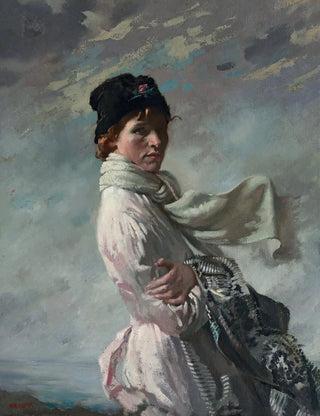Art print | In Dublin Bay, portrait of the artist's wife - William Orpen


View from behind

Frame (optional)
Art print In Dublin Bay, portrait of the artist's wife - William Orpen – Captivating introduction
In the fascinating universe of art, some works manage to capture not only the essence of a moment but also the soul of a relationship. "In Dublin Bay, portrait of the artist's wife" by William Orpen is one of those creations that transcends a simple portrait to offer an intimate glimpse into the artist's personal life. This piece, painted with remarkable delicacy and precision, transports us to a space where time seems suspended. As viewers contemplate this painting, they are invited to feel the deep connection between the artist and his model, while admiring the beauty of the Irish landscapes stretching into the background.
Style and uniqueness of the work
Orpen's style, at the crossroads between Impressionism and realism, is vividly expressed in this portrait. Light plays a crucial role, illuminating the face of the artist's wife in a way that evokes both tenderness and melancholy. The subtle nuances of color, from warm tones to delicate shadows, create an intimate atmosphere, almost tangible. Orpen does not merely reproduce the features of his wife; he captures an essence, an emotion, a moment frozen in time. The choice of setting, with Dublin Bay as a backdrop, is no coincidence. It reflects not only the artist's connection to his homeland but also the harmony between nature and human beings—a recurring theme in his work.
The artist and his influence
William Orpen, an emblematic figure of early 20th-century British art, knew how to leave his mark on his era with his innovative approach to portraiture. Trained at the Dublin Metropolitan School of Art and influenced by contemporary artistic movements, he developed a distinctive style that allowed him to stand out on the international scene. Orpen often explored themes of identity and memory through his works, seeking to reveal the psyche of his subjects rather than simply depicting them. His influence endures today, inspiring many contemporary artists to question the

Matte finish

View from behind

Frame (optional)
Art print In Dublin Bay, portrait of the artist's wife - William Orpen – Captivating introduction
In the fascinating universe of art, some works manage to capture not only the essence of a moment but also the soul of a relationship. "In Dublin Bay, portrait of the artist's wife" by William Orpen is one of those creations that transcends a simple portrait to offer an intimate glimpse into the artist's personal life. This piece, painted with remarkable delicacy and precision, transports us to a space where time seems suspended. As viewers contemplate this painting, they are invited to feel the deep connection between the artist and his model, while admiring the beauty of the Irish landscapes stretching into the background.
Style and uniqueness of the work
Orpen's style, at the crossroads between Impressionism and realism, is vividly expressed in this portrait. Light plays a crucial role, illuminating the face of the artist's wife in a way that evokes both tenderness and melancholy. The subtle nuances of color, from warm tones to delicate shadows, create an intimate atmosphere, almost tangible. Orpen does not merely reproduce the features of his wife; he captures an essence, an emotion, a moment frozen in time. The choice of setting, with Dublin Bay as a backdrop, is no coincidence. It reflects not only the artist's connection to his homeland but also the harmony between nature and human beings—a recurring theme in his work.
The artist and his influence
William Orpen, an emblematic figure of early 20th-century British art, knew how to leave his mark on his era with his innovative approach to portraiture. Trained at the Dublin Metropolitan School of Art and influenced by contemporary artistic movements, he developed a distinctive style that allowed him to stand out on the international scene. Orpen often explored themes of identity and memory through his works, seeking to reveal the psyche of his subjects rather than simply depicting them. His influence endures today, inspiring many contemporary artists to question the






